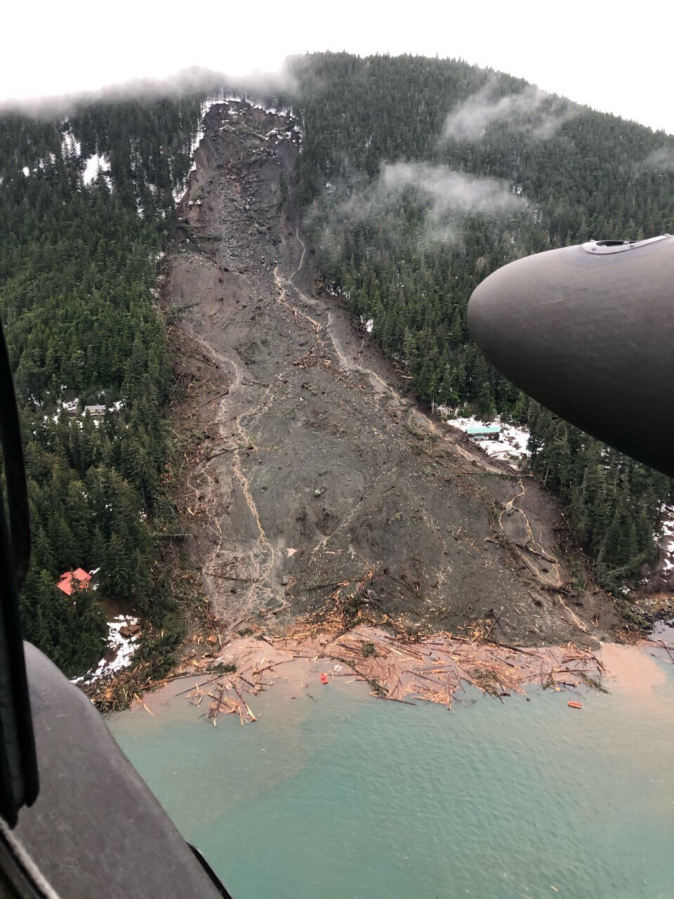ANCHORAGE, Alaska — Last month, a mountain slope near Wrangell let loose in drenching rains and gave way in a river of debris that killed five people and left an 11-year-old boy missing and presumed dead.
In December 2020, a similar scenario played out in Haines after a winter storm caused widespread flooding and triggered a landslide that destroyed homes, killing two residents.
In August 2015, it was Sitka where heavy rain triggered a landslide into a subdivision of homes under construction, leaving three people dead.
Over the past decade, landslides have cost Southeast Alaska communities in both death and destruction — 11 deaths and tens of millions of dollars in property and infrastructure damage.
Now communities around Southeast are reckoning with a future in which more destructive landslides are likely, as climate change fuels the extreme rainfall events and storms that scientists say may lead to increasingly powerful events in the future.
The most recent major landslide, on Nov. 20 at Mile 11 of the Zimovia Highway near Wrangell, was the deadliest Southeast Alaska slide in decades.
“It was a traumatic experience,” said Mason Villarma, Wrangell’s interim borough manager. “For the entire town.”
He’s seen people in the community of about 2,000 people grieving and slowly trying to resume their regular routines. But things are not the same.
“People have some residual fear,” Villarma said.
Balancing risk with limits of prediction
Around Alaska, between 30 and 40 scientists, engineers and others are working on landslide research, including a project to inventory historic slides to better understand zones of vulnerability over a vast landscape, said Lorraine Henry, a spokesperson for the Alaska Department of Natural Resources.
“There are multiple agencies, disciplines, and entities that are dedicated to landslide research and science in Alaska,” Henry wrote in an email.
Unlike areas exposed to tsunamis, however, Southeast Alaska doesn’t have a unified landslide warning system. Instead, communities have been developing their own mitigation and response strategies, one by one. Some Sitka residents have gone so far as to pioneer a grassroots landslide warning system that provides daily danger assessments.
But officials across the region emphasize how difficult it is to accurately predict landslides.
The Beach Road area in Haines where the 2020 slide hit wasn’t considered a high-risk area, said Robert Venables, executive director of Southeast Conference and a former Haines Borough manager.
“We went through quite a few storm events, and cataloged areas that we thought would be at risk, and kept an eye on those, but where that landslide happened, no one had a clue,” he said.
In the meantime, communities must balance the risk of future landslides with pressure to develop new housing on scarce buildable land.
“You’re either building at the foot of the mountain, or you’re building on the side of the mountain,” said Haines Mayor Tom Morphet. “We have very few flat areas that are not flood-prone or landslide-prone.”
‘Worse storms’
The way two quintessential Southeast Alaska elements — mountains and rain — combined into a deadly and destructive force has left some residents with a lingering sense of dread.
After the 2020 Haines landslide that killed two people, including her son’s kindergarten teacher, the joy of living surrounded by mountains was tempered by a sobering realization, said Sylvia Heinz, a Haines resident.
“Mountains are supposed to be strong. They’re part of our identity as Alaskans,” Heinz said. “The reality that those mountains — both figuratively and literally — can come down and kill your people at any time is hard to come to terms with.”
Many Southeast Alaska towns are strung along narrow strips of land between the ocean and the base of steep, forested slopes. The topography of the region is part of its allure — a place where mountains seem to rise straight out of the sea.
It’s also a landscape that can give rise to sudden landslides. The U.S. Forest Service has documented thousands of landslides across Southeast in the Tongass National Forest alone.
Scientists know what triggers landslides: A steep slope in combination with weather, wind, destabilized soils and rock. In the future, a warming climate means Alaska is likely to see more intense rainfall events, according to Rick Thoman, an Alaska climate specialist at the University of Alaska Fairbanks.
Models predict that a warming climate will bring increased precipitation to high latitudes like Alaska in the coming decades. In Haines, record rainfall in December 2020 preceded the deadly landslide and damaged an estimated 34 percent of households, according to the Haines Long Term Recovery Group.
“We fully expect that these extreme, short-duration rainfalls are going to go up, simply because there is more water vapor in the air,” Thoman said.
Weather is just one factor, along with unstable soils, steep slopes, and seismic activity that can trigger landslides, scientists say.
While landslides are a natural part of the Panhandle’s rainforest ecosystem, research generally shows logging can destabilize soils and expose slopes to saturation with rain, influencing the frequency and size of slides, according to reporting in The Seattle Times. A 2017 Washington State University study found landslides on logged forests in the Northwest would become more widespread as the climate changes.
The climate factor is “unequivocal,” said Gabriel Wolken, a geologist with the Alaska Department of Natural Resources’ geologic hazards program: “The climate is changing and producing more storms and worse storms, and those tend to influence how landslides happen.” In the hours before the Wrangell landslide in November, the town received about 2 inches of rain and saw wind gusts of up to 60 mph, according to the National Weather Service.
Compared to countries such as Switzerland or Japan, which have advanced mapping and mitigation plans for landslide risks, Alaska still has a long way to go in understanding its landslide hazards, Wolken said.
“It’s a big and unwieldy” task, he said.



